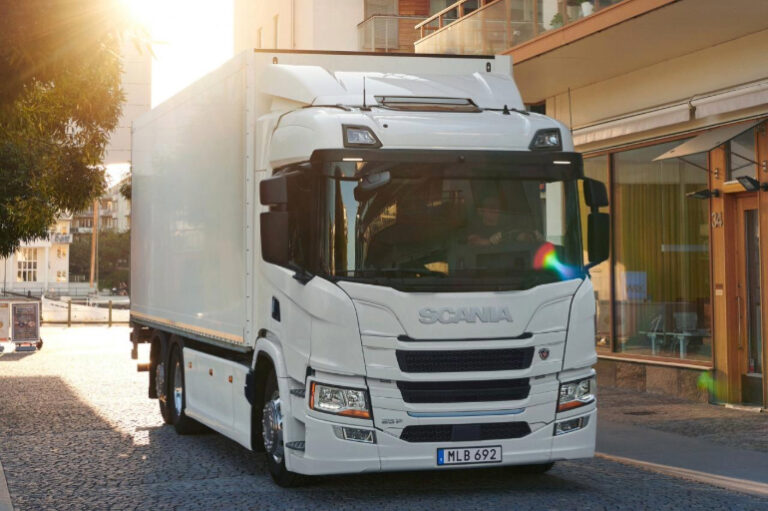Scania has long been recognised as a leader in the commercial vehicle space, but beyond delivering high-quality trucks, its mission extends to two fundamental pillars: safety and sustainability. These aren’t just buzzwords for the Swedish manufacturer—they are deeply embedded in Scania’s DNA. Managing Director of Scania Australia, Manfred Streit, recently spoke with Fleet News Group about the importance of these values and how they drive the company’s approach to vehicle design, total cost of ownership, and the transition to lower emissions transport.
Sustainability as a Long-Term Commitment
Sustainability in transport has become an unavoidable conversation, with both government and industry players exploring ways to reduce emissions. While Europe has been a frontrunner in alternative drive technologies, Streit believes there are valuable lessons that Australian fleets can learn from their European counterparts. However, he is quick to point out that it is not a simple case of replicating what has worked overseas.
“You cannot copy Europe here, definitely not because of the climate, because of the geographical conditions, and also because of the geopolitical demographics,” Streit explained. “But we have started with ethanol, with gas—natural gas, compressed natural gas, liquefied natural gas. We are working a bit on hydrogen, although we think it’s a bit of a waste of energy. We are doing all sorts of things to reduce carbon emissions.”
While many in the industry equate sustainability with electrification, Streit emphasises that the transition is not a single-step process. Scania is actively developing its diesel combustion engine technology to improve fuel efficiency, recognising that diesel will remain essential for many applications in Australia due to the country’s vast distances and operational demands.
“Our Super engine improved efficiency, and efficiency means less fuel consumption, which lowers total cost of ownership. But it also means less pollution or lower CO₂ emissions,” he said. “Even if it’s only an 8 to 10% improvement, multiply that by thousands of vehicles, and the impact is significant.”
Government Support is Crucial
A key factor that has accelerated decarbonisation in Europe is government intervention, something that is still lacking in Australia. Streit believes that without targeted policies, such as incentives for cleaner vehicles or penalties for older, higher-emission trucks, the market will be slow to transition.
“In Europe, the government really drove this. They introduced road taxes where Euro 6 trucks paid less than Euro 5, and Euro 5 paid less than Euro 4. If you were running a Euro 3 truck, the costs became too high, forcing operators to upgrade,” he said. “That piece is missing in Australia. If the government really wants to lower emissions, they need to put policies in place that encourage fleet renewal.”
Safety First: Setting the Benchmark in the Industry
When it comes to safety, Scania has been a pioneer, often setting the standard for what should be considered essential in heavy vehicles. The company was the first to introduce rollover airbags as standard in its prime mover fleet, addressing one of the most significant risks to truck drivers.
“We are still the only brand that has curtain airbags in heavy vehicles,” noted Ben Nye, Scania Australia’s Product Manager. “Rollovers are the number one cause of truck driver fatalities, and this technology is critical.”
Another major step forward has been the increase in truck width from 2.5 to 2.55 metres, allowing Scania to bring in additional safety features that were previously restricted due to size limitations.
Scania has also led the way in telematics and connected technologies, enabling fleet managers to monitor driver behaviour and vehicle performance remotely. The introduction of Scania’s driver scoring system, which provides real-time feedback on braking, acceleration, and fuel consumption, has helped many fleets improve both safety and efficiency.
“Our trucks provide live feedback to drivers, telling them when to ease off the accelerator before a hill or when to release the retarder earlier,” Nye explained. “Fleet managers can use this data to encourage safer driving habits and even run competitions among drivers to improve their scores.”
A Holistic Approach to Vehicle Lifecycle Management
Scania’s approach to sustainability and safety extends beyond just the truck itself. The company places a strong emphasis on total cost of ownership (TCO), ensuring that operators get the most value over a vehicle’s lifespan.
“We do everything ourselves—the drivetrain, axles, gearbox, and engine. This allows us to optimise the entire system for maximum efficiency,” Streit said. “We also prefer to maintain our own workshops because it keeps a direct connection between the engineers, manufacturers, and the people maintaining the vehicles.”
Scania’s maintenance contracts and financing options have been widely adopted, with approximately 50% of customers choosing to include a service contract with their vehicle purchase. These contracts help operators plan costs more accurately and reduce the risks associated with unexpected repairs.
“With a maintenance contract, you have a fixed monthly fee for a set period, meaning you can calculate your costs upfront,” Streit said. “It’s about taking the guesswork out of running a fleet.”
What’s Next for Scania in Australia?
Looking ahead, Scania Australia will continue to introduce new technologies that improve safety, efficiency, and sustainability. The company is actively developing new axle configurations for heavy applications, refining its connected vehicle technologies, and testing autonomous solutions.
“We have already introduced autonomous trucks in mining, and we’re working on bringing these technologies to on-road applications,” Streit said. “Everything we do, whether it’s improving our engines, adding new safety features, or enhancing vehicle connectivity, is about making transport more efficient and sustainable.”
For fleet operators in Australia, Scania’s commitment to innovation provides a clear path towards reducing emissions while maintaining profitability. However, as Streit highlights, meaningful progress will require collaboration between manufacturers, fleet operators, and government stakeholders.
“The sooner we act, the better the outcome,” he said. “It’s not about choosing between diesel and electric. It’s about taking every possible step to lower emissions and improve safety, one vehicle at a time.”






